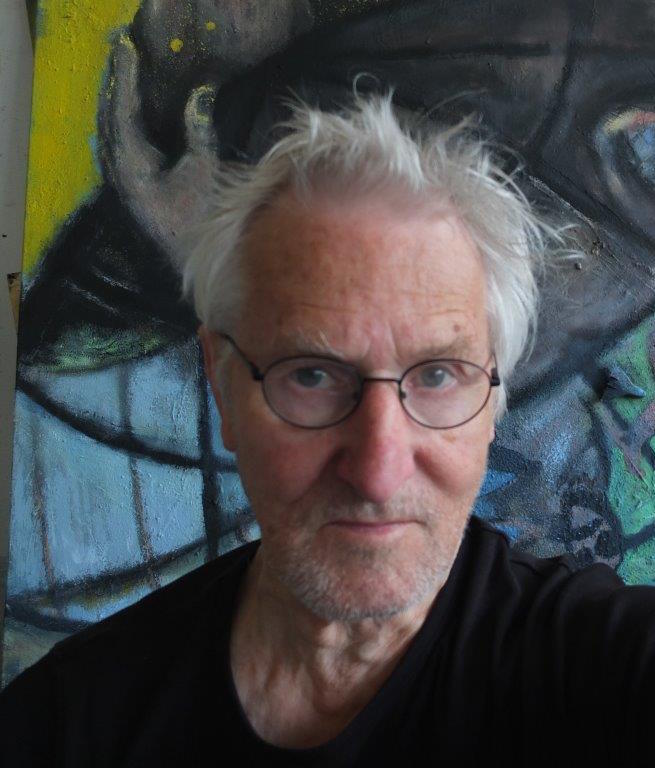Werkthemen + Vita + AusstellungenBrunners Arbeiten sind so vielschichtig wie seine Vita. Nietzsche, der mythische Atlas, die Arche, überhaupt Architektur und Politik und Literatur (diese Liste ist noch lange nicht am Ende) - all das findet in seinem Werk ein Echo. Dabei ist seine Arbeit vieles, nur eines eben nicht: beliebig.
Der gelernte Schmied aus Oberammergau, ehemalige Architekt und archäologische Bauforscher untersucht so immer wieder das Spannungsfeld zwischen Mensch und seiner Lebenswelt, findet ihren gestalterischen Ausdruck. Er verwendet Zeitungsmeldungen, Fotografien, Zitate, montiert und übermalt sein Material, lässt es im großen malerischen Ausdruck verschwinden oder ironisch (selten auch böse) aufblitzen oder durchschimmern. Doch Werner Brunner montiert nicht nur Zitate in seine Kunst, sondern modelliert aus diesen Zitaten seine Kunst heraus. Er ist ein Schöpfer, kein Porträtist. Brunner kann nur malen, was er vorher auch gedacht hat. Dass ihn für dieses Malen ein großartiges Handwerk zur Verfügung steht, ist nur eine weitere gute Nachricht! Seine Bilder sind schön. Seine Gedanken klar. Das Werk, wie er selbst, vielschichtig. - Christian Duda Im Niederländischen NRC-Handelsblat (26.03.1990, S.9) wurde seine engagierte Malerei in einem Atemzug mit der Band U2, Enzensberger und Tracy Chapman genannt. |
Work + Biography + CV
Werner Brunner’s work is as multifaceted as his biography. Nietzsche, the mythical Atlas, the biblical Ark and even architecture, politics and literature- all are subjects that find expression within his paintings. His art is anything but provincial, given the broad scope of the philosophical and contemporary topics that his work addresses.As a trained blacksmith from Oberammergau, former architect and archeological researcher, Brunner’s investigation of man’s interaction with his surroundings are expressed time and time again within his paintings.
He layers newspaper articles, photographs, quotes onto his canvases before covering them with broad, bold brushstrokes, still allowing parts of the montages to be seen through the transparent coats of paint. Brunner is not just inserting quotes in his art but uses the quotes as the source of inspiration for the image.
He is a creator, not a portraitist. Brunner can only paint that which he has already conceptualized. However, the fact that he has the wonderful medium of painting at his disposal to transform these abstract concepts into tangible works of art is just another plus. His paintings are beautiful. His thoughts are clear. His work is as multifaceted as he is.
- Christian Duda
He layers newspaper articles, photographs, quotes onto his canvases before covering them with broad, bold brushstrokes, still allowing parts of the montages to be seen through the transparent coats of paint. Brunner is not just inserting quotes in his art but uses the quotes as the source of inspiration for the image.
He is a creator, not a portraitist. Brunner can only paint that which he has already conceptualized. However, the fact that he has the wonderful medium of painting at his disposal to transform these abstract concepts into tangible works of art is just another plus. His paintings are beautiful. His thoughts are clear. His work is as multifaceted as he is.
- Christian Duda
Werner Brunner- Arche & Atlas. Unter der Last der Wirklichkeit
- Film von Diana Vishnevskaya und Igor Zwetkow für die Galerie Kuchling
Wer nicht hören will muss sehen: Das Leben und Werk Werner Brunners und die Künstlerkollektive Ratgeb
My research follows the work of the artist group Ratgeb, a collective of five West German artists from the generation of Germans who grew up in the immediate aftermath of the Second World War. During the eight years that the group was active, the Ratgeb Collective worked with squatters, school children, teenage runaways, immigrant minorities, juvenile delinquents and even a biker gang to create more than a dozen large-scale murals within Berlin. Eleven of these murals can still be seen today, nearly four decades after their creation. My thesis focuses on both Ratgeb’s commissioned and illegal mural projects, all of which comment on the housing crisis that arose in the 1980s following the retail speculation government officials had organized with foreign investors. The namesake of the group, and honorary sixth member, Jörg Ratgeb was an altar and fresco painter who regularly infused his religious paintings with messages of political dissent, and was later executed due to his leadership role in the Farmer’s uprising.
In honor of this early fellow German artist and activist, the Collective Ratgeb adopted not only his name but his revolutionary drive to use murals as a means of communicating the wants and needs of those civilians that had been overlooked and neglected by government officials and the social elite of West Berlin.
- Emily Moore, 2018
In honor of this early fellow German artist and activist, the Collective Ratgeb adopted not only his name but his revolutionary drive to use murals as a means of communicating the wants and needs of those civilians that had been overlooked and neglected by government officials and the social elite of West Berlin.
- Emily Moore, 2018
Webseite erstellt von Emily Moore - emilybjodstrupmoore.weebly.com

